PHP - Introduction to Object Oriented Programming with PHP
Download as ppt, pdf1 like3,625 views
This ppt gives information about: 1. OOPs Theory 2. Defining a Class 3. Creating an Object 4. The $this Attribute 5. Creating Constructors 6. Creating Destructors
1 of 22
Downloaded 95 times
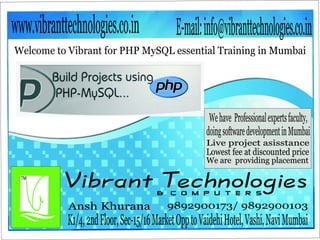

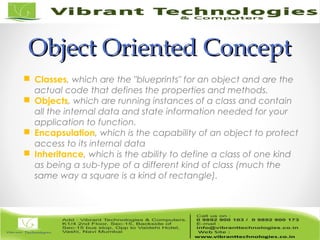

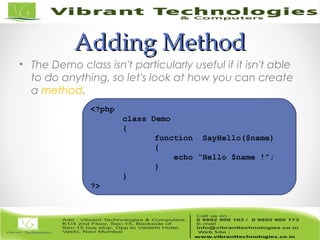
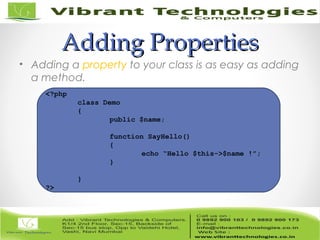


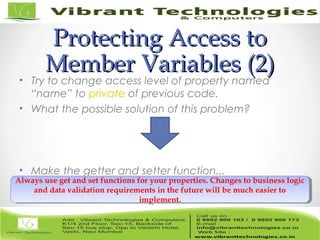
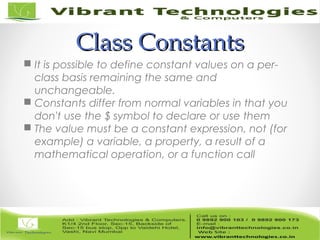
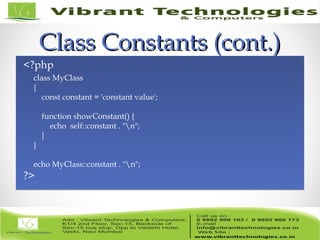
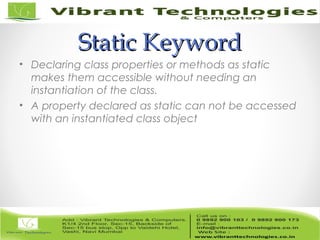
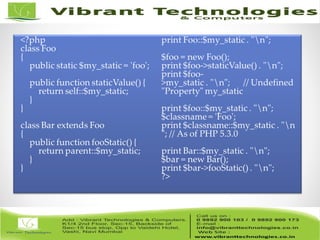

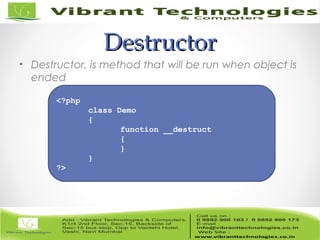
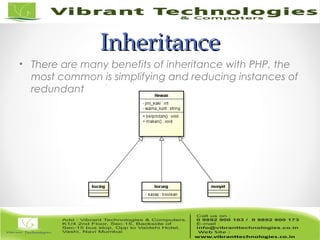
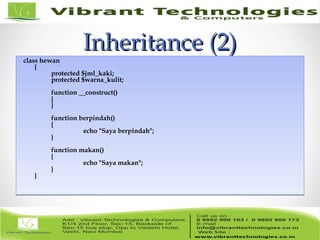
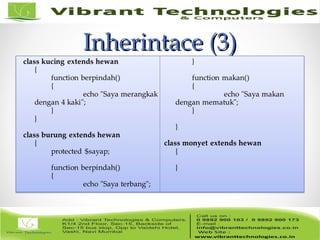
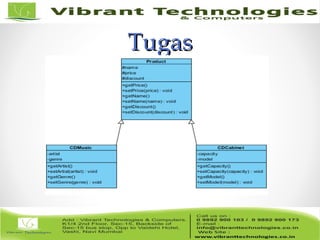

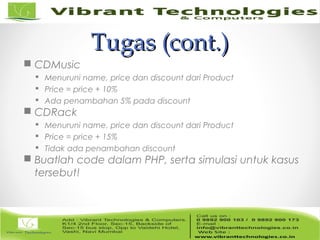

Ad
Recommended
Power Point Presentation on Artificial Intelligence 



Power Point Presentation on Artificial Intelligence Anushka Ghosh Its a Power Point Presentation on Artificial Intelligence.I hope you will find this helpful. Thank you.
You can also find out my another PPT on Artificial Intelligence.The link is given below--
https://www.slideshare.net/AnushkaGhosh5/ppt-presentation-on-artificial-intelligence
Anushka Ghosh
PHP - Introduction to File Handling with PHP



PHP - Introduction to File Handling with PHPVibrant Technologies & Computers This PPT gives Information about:
1. HTTP Headers,
2. Page Redirect,
3. File Uploading
4. File Downloading
Exercices uml-corrige



Exercices uml-corrigeAmineMouhout1 Correction td Uml
diagramme de classe
diagramme de cas d'utilisation
diagramme de séquence
diagramme de collaboration
Introduction to data structure ppt



Introduction to data structure pptNalinNishant3 In computer science, a data structure is a data organization, management, and storage format that enables efficient access and modification. More precisely, a data structure is a collection of data values, the relationships among them, and the functions or operations that can be applied to the data. https://apkleet.com
<a href="https://apkleet.com" >games apk </a>
Html Ppt



Html Pptvijayanit HTML (Hypertext Markup Language) is used to define the structure and layout of web pages using a variety of tags and attributes. Some key points covered are:
- HTML documents use tags like <html> enclosed in angle brackets to describe headings, paragraphs, links, images, and other content.
- Tags normally come in pairs with opening and closing tags.
- HTML can be used to format text, add images and tables, create lists and forms, structure pages using divs and frames, and more.
- CSS (Cascading Style Sheets) is often used to define styles and layouts, separate from HTML content.
- Forms allow users to enter data through
javascript objects



javascript objectsVijay Kalyan Objects in JavaScript can be created using object literals, the new keyword, or Object.create(). Objects are collections of properties and methods that are mutable and manipulated by reference. Arrays are objects that represent ordered collections of values of any type and are created using array literals or the Array constructor. Common array methods include concat, join, pop, push, reverse, and sort. The Math object provides common mathematical functions like pow, round, ceil, floor, random, and trigonometric functions.
Prediction of heart disease using machine learning.pptx



Prediction of heart disease using machine learning.pptxkumari36 1. The document discusses using machine learning techniques to predict heart disease by evaluating large datasets to identify patterns that can help predict, prevent, and manage conditions like heart attacks.
2. It proposes using data analytics based on support vector machines and genetic algorithms to diagnose heart disease, claiming genetic algorithms provide the best optimized prediction models.
3. The key modules described are uploading training data, pre-processing the heart disease data, using machine learning to predict heart disease, and generating graphical representations of the analyses.
Network security - OSI Security Architecture



Network security - OSI Security ArchitectureBharathiKrishna6 The OSI Security Architecture provides a systematic framework for defining security attacks, mechanism, and services.
Oops concepts in php



Oops concepts in phpCPD INDIA Object Oriented Programming (OOP) is the programming method that involves the use of the data , structure and organize classes of an application.
Php mysql ppt



Php mysql pptKarmatechnologies Pvt. Ltd. PHP is a server-side scripting language used to create dynamic web pages. It allows embedding PHP code within HTML pages and interacting with databases. Key elements of PHP include variables, control structures, functions, and sessions. Sessions store user data on the server instead of the client to avoid cookies and allow tracking users across multiple pages.
Web Development Course: PHP lecture 1



Web Development Course: PHP lecture 1Gheyath M. Othman PHP is a server-side scripting language commonly used for web development. It allows files containing text, HTML, and PHP scripts to be processed on the server and returned to the browser as plain HTML. PHP can generate dynamic page content, interact with databases, send and receive cookies, and more. Some key features of PHP include that it is free, open source, runs on most server environments, and can be easily learned. The document provides examples of basic PHP syntax, variables, data types, operators, and conditional statements.
Lab #2: Introduction to Javascript



Lab #2: Introduction to JavascriptWalid Ashraf This document provides an introduction to JavaScript and its uses for web programming. It explains that JavaScript is a client-side scripting language that allows web pages to become interactive. Some key points covered include:
- JavaScript can change HTML content, styles, validate data, and make calculations.
- Functions are blocks of code that perform tasks when invoked by events or called in code.
- Events like clicks or keyboard presses trigger JavaScript code.
- The DOM (Document Object Model) represents an HTML document that JavaScript can access and modify.
- Forms and user input can be accessed and processed using the DOM.
- Programming flow can be controlled with conditional and loop statements.
-
Php and MySQL



Php and MySQLTiji Thomas This document provides an overview of PHP and MySQL. It defines PHP as a server-side scripting language that is commonly used with MySQL, an open-source database management system. The document discusses key PHP concepts like PHP files, variables, operators, conditional statements, arrays, loops, and functions. It also covers form handling in HTML and PHP. The intended audience is users looking to learn the basics of PHP and how it integrates with MySQL for database management.
Spring Boot and REST API



Spring Boot and REST API07.pallav Spring Boot is a framework for creating stand-alone, production-grade Spring-based applications that can be started using java -jar without requiring any traditional application servers. It is designed to get developers up and running as quickly as possible with minimal configuration. Some key features of Spring Boot include automatic configuration, starter dependencies to simplify dependency management, embedded HTTP servers, security, metrics, health checks and externalized configuration. The document then provides examples of building a basic RESTful web service with Spring Boot using common HTTP methods like GET, POST, PUT, DELETE and handling requests and responses.
Form Handling using PHP



Form Handling using PHPNisa Soomro This document discusses HTML forms and how they are used to send data to a server. It explains the GET and POST methods for sending form data, as well as the PHP superglobal variables ($_GET, $_POST, $_REQUEST) that are used to collect the data on the server side. The GET method appends data to the URL and has limitations on size, while the POST method embeds data in the HTTP request body and has no size limits, making it more secure for sensitive data. Both methods create arrays of key-value pairs from the form fields to populate the respective superglobal variables.
JDBC – Java Database Connectivity



JDBC – Java Database ConnectivityInformation Technology The document discusses Java Database Connectivity (JDBC) which allows Java applications to connect to databases. It describes the JDBC architecture including drivers, loading drivers, connecting to databases, executing queries and updates using Statement and PreparedStatement objects, processing result sets, and handling exceptions. It also covers transactions, result set metadata, and cleaning up resources.
C# classes objects



C# classes objectsDr.Neeraj Kumar Pandey The document discusses key concepts of classes and objects in C# including defining classes, adding variables and methods, member access modifiers, creating objects, constructors, static members, private constructors, and indexers. It defines classes as user defined data types that can encapsulate data as fields and functions as methods. Objects are instances of classes that allow data and methods to be accessed. Constructors initialize objects, while static members are associated with the class rather than individual objects.
Loops PHP 04



Loops PHP 04mohamedsaad24 PHP course Lecture 4
Contents
PHP Array Functions
while - loop
do...while
for - loop
foreach
jQuery



jQueryDileep Mishra The document provides an overview of jQuery including:
- What jQuery is and its main features like DOM manipulation and AJAX
- How to include jQuery in an HTML document and basic usage syntax
- jQuery selectors to find elements and filters to refine selections
- Common jQuery methods for manipulating attributes, events, HTML, CSS, and more
- Examples of using various jQuery functions and concepts
Javascript



JavascriptManav Prasad JavaScript is a scripting language used primarily for client-side web development. It is based on the ECMAScript standard but browsers support additional objects like Window and DOM objects. JavaScript can be used to create dynamic and interactive effects on web pages like menus, alerts, and updating content without reloading. It is commonly used for form validation, AJAX applications, and other interactive features. The document provides examples of basic JavaScript concepts like variables, data types, operators, and control structures and how to embed scripts in HTML.
Introduction to php



Introduction to phpTaha Malampatti This ppt wil guide all computer science engineering students through the Introduction of PHP programming language.
Css selectors



Css selectorsParth Trivedi There are 6 types of CSS selectors: simple, class, generic, ID, universal, and pseudo-class selectors. Simple selectors apply styles to single elements. Class selectors allow assigning different styles to the same element on different occurrences. ID selectors define special styles for specific elements. Generic selectors define styles that can be applied to any tag. Universal selectors apply styles to all elements on a page. Pseudo-class selectors give special effects like focus and hover.
Dom



DomRakshita Upadhyay The presentation provides an introduction to the Document Object Model (DOM) and how it allows JavaScript to access and modify HTML documents. It discusses how the DOM presents an HTML document as a tree structure, and how JavaScript can then restructure the document by adding, removing, or changing elements. It also gives examples of how DOM properties and methods allow accessing and manipulating specific nodes, such as changing the background color of the document body.
Oops in PHP



Oops in PHPMindfire Solutions The document discusses object oriented concepts in PHP. Some key points:
- PHP 5 introduced a complete object oriented programming model, allowing PHP programmers to code like Java and C#.
- Object oriented programming in PHP revolves around classes, which act as templates to define objects. Classes contain properties (variables) and methods (functions).
- The document provides a step-by-step process for developing an object oriented PHP application, including creating classes, instantiating objects from classes, setting and getting object properties and methods, and restricting access using modifiers.
JavaScript - Chapter 6 - Basic Functions



JavaScript - Chapter 6 - Basic FunctionsWebStackAcademy A JavaScript function is a block of code designed to perform a particular task.
Why Functions?
You can reuse code: Define the code once, and use it many times. You can use the same code many times with different arguments, to produce different results.
Functions in javascript



Functions in javascriptbaabtra.com - No. 1 supplier of quality freshers The document provides information about a mentoring program run by Baabtra-Mentoring Partner including a trainee's typing speed progress over 3 weeks, jobs applied to with current statuses, an introduction to functions in Javascript covering definitions, advantages, examples, and local and global variables. Contact details for Baabtra are also provided at the end.
Jsp ppt



Jsp pptVikas Jagtap This document provides an overview of Java Server Pages (JSP) technology. Some key points:
- JSP allows separation of work between web designers and developers by allowing HTML/CSS design and Java code to be placed in the same file.
- A JSP page is compiled into a servlet, so it can take advantage of servlet features like platform independence and database-driven applications.
- JSP pages use tags like <jsp:include> and <jsp:useBean> to include content and access JavaBeans. Scriptlets, expressions, declarations, and directives are also used.
- Implicit objects like request, response, out, and session are automatically available in JSP pages
JavaScript - Chapter 12 - Document Object Model



JavaScript - Chapter 12 - Document Object ModelWebStackAcademy What is the DOM?
The DOM is a W3C (World Wide Web Consortium) standard.
The DOM defines a standard for accessing documents:
"The W3C Document Object Model (DOM) is a platform and language-neutral interface that allows programs and scripts to dynamically access and update the content, structure, and style of a document."
The W3C DOM standard is separated into 3 different parts:
Core DOM - standard model for all document types
XML DOM - standard model for XML documents
HTML DOM - standard model for HTML documents
The HTML DOM (Document Object Model)
When a web page is loaded, the browser creates a Document Object Model of the page.
The HTML DOM model is constructed as a tree of Objects.
With the HTML DOM, JavaScript can access and change all the elements of an HTML document.
Object Oriented Programming in PHP



Object Oriented Programming in PHPLorna Mitchell Object Oriented Programming (OOP) allows developers to organize complex programs using classes and objects. OOP uses concepts like encapsulation, inheritance and polymorphism to keep data and functionality together in objects. The basic building blocks in OOP are classes, which define the properties and methods of an object, and objects, which are instances of classes. Classes can inherit properties and methods from parent classes, and objects can be identified and compared using operators like instanceof. Magic methods allow objects to override default behavior for operations like property access, method calling and object destruction.
Object Oriented Programming Concepts



Object Oriented Programming Conceptsthinkphp The document discusses key concepts in object-oriented programming including objects, classes, messages, and requirements for object-oriented languages. An object is a bundle of related variables and methods that can model real-world things. A class defines common variables and methods for objects of a certain kind. Objects communicate by sending messages to each other specifying a method name and parameters. For a language to be object-oriented, it must support encapsulation, inheritance, and dynamic binding.
More Related Content
What's hot (20)
Oops concepts in php



Oops concepts in phpCPD INDIA Object Oriented Programming (OOP) is the programming method that involves the use of the data , structure and organize classes of an application.
Php mysql ppt



Php mysql pptKarmatechnologies Pvt. Ltd. PHP is a server-side scripting language used to create dynamic web pages. It allows embedding PHP code within HTML pages and interacting with databases. Key elements of PHP include variables, control structures, functions, and sessions. Sessions store user data on the server instead of the client to avoid cookies and allow tracking users across multiple pages.
Web Development Course: PHP lecture 1



Web Development Course: PHP lecture 1Gheyath M. Othman PHP is a server-side scripting language commonly used for web development. It allows files containing text, HTML, and PHP scripts to be processed on the server and returned to the browser as plain HTML. PHP can generate dynamic page content, interact with databases, send and receive cookies, and more. Some key features of PHP include that it is free, open source, runs on most server environments, and can be easily learned. The document provides examples of basic PHP syntax, variables, data types, operators, and conditional statements.
Lab #2: Introduction to Javascript



Lab #2: Introduction to JavascriptWalid Ashraf This document provides an introduction to JavaScript and its uses for web programming. It explains that JavaScript is a client-side scripting language that allows web pages to become interactive. Some key points covered include:
- JavaScript can change HTML content, styles, validate data, and make calculations.
- Functions are blocks of code that perform tasks when invoked by events or called in code.
- Events like clicks or keyboard presses trigger JavaScript code.
- The DOM (Document Object Model) represents an HTML document that JavaScript can access and modify.
- Forms and user input can be accessed and processed using the DOM.
- Programming flow can be controlled with conditional and loop statements.
-
Php and MySQL



Php and MySQLTiji Thomas This document provides an overview of PHP and MySQL. It defines PHP as a server-side scripting language that is commonly used with MySQL, an open-source database management system. The document discusses key PHP concepts like PHP files, variables, operators, conditional statements, arrays, loops, and functions. It also covers form handling in HTML and PHP. The intended audience is users looking to learn the basics of PHP and how it integrates with MySQL for database management.
Spring Boot and REST API



Spring Boot and REST API07.pallav Spring Boot is a framework for creating stand-alone, production-grade Spring-based applications that can be started using java -jar without requiring any traditional application servers. It is designed to get developers up and running as quickly as possible with minimal configuration. Some key features of Spring Boot include automatic configuration, starter dependencies to simplify dependency management, embedded HTTP servers, security, metrics, health checks and externalized configuration. The document then provides examples of building a basic RESTful web service with Spring Boot using common HTTP methods like GET, POST, PUT, DELETE and handling requests and responses.
Form Handling using PHP



Form Handling using PHPNisa Soomro This document discusses HTML forms and how they are used to send data to a server. It explains the GET and POST methods for sending form data, as well as the PHP superglobal variables ($_GET, $_POST, $_REQUEST) that are used to collect the data on the server side. The GET method appends data to the URL and has limitations on size, while the POST method embeds data in the HTTP request body and has no size limits, making it more secure for sensitive data. Both methods create arrays of key-value pairs from the form fields to populate the respective superglobal variables.
JDBC – Java Database Connectivity



JDBC – Java Database ConnectivityInformation Technology The document discusses Java Database Connectivity (JDBC) which allows Java applications to connect to databases. It describes the JDBC architecture including drivers, loading drivers, connecting to databases, executing queries and updates using Statement and PreparedStatement objects, processing result sets, and handling exceptions. It also covers transactions, result set metadata, and cleaning up resources.
C# classes objects



C# classes objectsDr.Neeraj Kumar Pandey The document discusses key concepts of classes and objects in C# including defining classes, adding variables and methods, member access modifiers, creating objects, constructors, static members, private constructors, and indexers. It defines classes as user defined data types that can encapsulate data as fields and functions as methods. Objects are instances of classes that allow data and methods to be accessed. Constructors initialize objects, while static members are associated with the class rather than individual objects.
Loops PHP 04



Loops PHP 04mohamedsaad24 PHP course Lecture 4
Contents
PHP Array Functions
while - loop
do...while
for - loop
foreach
jQuery



jQueryDileep Mishra The document provides an overview of jQuery including:
- What jQuery is and its main features like DOM manipulation and AJAX
- How to include jQuery in an HTML document and basic usage syntax
- jQuery selectors to find elements and filters to refine selections
- Common jQuery methods for manipulating attributes, events, HTML, CSS, and more
- Examples of using various jQuery functions and concepts
Javascript



JavascriptManav Prasad JavaScript is a scripting language used primarily for client-side web development. It is based on the ECMAScript standard but browsers support additional objects like Window and DOM objects. JavaScript can be used to create dynamic and interactive effects on web pages like menus, alerts, and updating content without reloading. It is commonly used for form validation, AJAX applications, and other interactive features. The document provides examples of basic JavaScript concepts like variables, data types, operators, and control structures and how to embed scripts in HTML.
Introduction to php



Introduction to phpTaha Malampatti This ppt wil guide all computer science engineering students through the Introduction of PHP programming language.
Css selectors



Css selectorsParth Trivedi There are 6 types of CSS selectors: simple, class, generic, ID, universal, and pseudo-class selectors. Simple selectors apply styles to single elements. Class selectors allow assigning different styles to the same element on different occurrences. ID selectors define special styles for specific elements. Generic selectors define styles that can be applied to any tag. Universal selectors apply styles to all elements on a page. Pseudo-class selectors give special effects like focus and hover.
Dom



DomRakshita Upadhyay The presentation provides an introduction to the Document Object Model (DOM) and how it allows JavaScript to access and modify HTML documents. It discusses how the DOM presents an HTML document as a tree structure, and how JavaScript can then restructure the document by adding, removing, or changing elements. It also gives examples of how DOM properties and methods allow accessing and manipulating specific nodes, such as changing the background color of the document body.
Oops in PHP



Oops in PHPMindfire Solutions The document discusses object oriented concepts in PHP. Some key points:
- PHP 5 introduced a complete object oriented programming model, allowing PHP programmers to code like Java and C#.
- Object oriented programming in PHP revolves around classes, which act as templates to define objects. Classes contain properties (variables) and methods (functions).
- The document provides a step-by-step process for developing an object oriented PHP application, including creating classes, instantiating objects from classes, setting and getting object properties and methods, and restricting access using modifiers.
JavaScript - Chapter 6 - Basic Functions



JavaScript - Chapter 6 - Basic FunctionsWebStackAcademy A JavaScript function is a block of code designed to perform a particular task.
Why Functions?
You can reuse code: Define the code once, and use it many times. You can use the same code many times with different arguments, to produce different results.
Functions in javascript



Functions in javascriptbaabtra.com - No. 1 supplier of quality freshers The document provides information about a mentoring program run by Baabtra-Mentoring Partner including a trainee's typing speed progress over 3 weeks, jobs applied to with current statuses, an introduction to functions in Javascript covering definitions, advantages, examples, and local and global variables. Contact details for Baabtra are also provided at the end.
Jsp ppt



Jsp pptVikas Jagtap This document provides an overview of Java Server Pages (JSP) technology. Some key points:
- JSP allows separation of work between web designers and developers by allowing HTML/CSS design and Java code to be placed in the same file.
- A JSP page is compiled into a servlet, so it can take advantage of servlet features like platform independence and database-driven applications.
- JSP pages use tags like <jsp:include> and <jsp:useBean> to include content and access JavaBeans. Scriptlets, expressions, declarations, and directives are also used.
- Implicit objects like request, response, out, and session are automatically available in JSP pages
JavaScript - Chapter 12 - Document Object Model



JavaScript - Chapter 12 - Document Object ModelWebStackAcademy What is the DOM?
The DOM is a W3C (World Wide Web Consortium) standard.
The DOM defines a standard for accessing documents:
"The W3C Document Object Model (DOM) is a platform and language-neutral interface that allows programs and scripts to dynamically access and update the content, structure, and style of a document."
The W3C DOM standard is separated into 3 different parts:
Core DOM - standard model for all document types
XML DOM - standard model for XML documents
HTML DOM - standard model for HTML documents
The HTML DOM (Document Object Model)
When a web page is loaded, the browser creates a Document Object Model of the page.
The HTML DOM model is constructed as a tree of Objects.
With the HTML DOM, JavaScript can access and change all the elements of an HTML document.
Viewers also liked (13)
Object Oriented Programming in PHP



Object Oriented Programming in PHPLorna Mitchell Object Oriented Programming (OOP) allows developers to organize complex programs using classes and objects. OOP uses concepts like encapsulation, inheritance and polymorphism to keep data and functionality together in objects. The basic building blocks in OOP are classes, which define the properties and methods of an object, and objects, which are instances of classes. Classes can inherit properties and methods from parent classes, and objects can be identified and compared using operators like instanceof. Magic methods allow objects to override default behavior for operations like property access, method calling and object destruction.
Object Oriented Programming Concepts



Object Oriented Programming Conceptsthinkphp The document discusses key concepts in object-oriented programming including objects, classes, messages, and requirements for object-oriented languages. An object is a bundle of related variables and methods that can model real-world things. A class defines common variables and methods for objects of a certain kind. Objects communicate by sending messages to each other specifying a method name and parameters. For a language to be object-oriented, it must support encapsulation, inheritance, and dynamic binding.
PHP Classes and OOPS Concept



PHP Classes and OOPS ConceptDot Com Infoway - Custom Software, Mobile, Web Application Development and Digital Marketing Company This document provides an introduction to object-oriented programming concepts in PHP including defining classes, creating objects, using methods and properties, inheritance, and the differences between OOP in PHP4 and PHP5. Classes define objects with attributes and behaviors, objects are instantiated from classes and can access methods and properties, and child classes inherit attributes and behaviors from parent classes.
OOP in PHP



OOP in PHPAlena Holligan If you are new to programing in general OR if you started programing in php before Object-Oriented Programming was even available, this presentation is designed to help you get up to speed on Object-Oriented terminology and give you practical skills as well as resources to continue learning.
A Gentle Introduction To Object Oriented Php



A Gentle Introduction To Object Oriented PhpMichael Girouard The document provides an introduction to object oriented programming concepts in PHP. It discusses the differences between procedural and object oriented code, basic OO concepts like classes, objects, properties, methods, constructors and destructors. It also covers inheritance, visibility, static members, and differences between PHP4 and PHP5 OOP. It uses requests as a case study and provides homework and suggested reading.
Java Servlets & JSP



Java Servlets & JSPManjunatha RK A Java servlet is a server-side program that processes requests from clients. Servlets offer improved performance over CGI by remaining loaded in memory between requests. The Servlet API defines interfaces and classes for writing servlets, including Servlet, ServletRequest, and ServletResponse. Tomcat is a popular servlet container for developing and testing servlets. A basic "Hello World" servlet uses the Servlet API to write a response containing HTML.
C vs c++



C vs c++Gaurav Badhan C and C++ are programming languages with many similarities but some key differences. They both use basic built-in data types and control structures. However, C++ supports object-oriented programming features like classes, data hiding, and inheritance that are not present in C. C++ also supports function overloading, namespaces, and references, which provide more flexibility than C at the cost of additional complexity. Overall, C++ can be seen as an enhancement of C with additional high-level programming capabilities.
JSP



JSPvikram singh Java Server Pages (JSP) is a technology that allows developers to create dynamic web applications using Java code embedded in HTML pages. JSP pages are compiled into Java servlets, allowing dynamic content to be generated. JSP supports the use of scripting elements like expressions, scriptlets, and declarations directly in HTML pages to add dynamic functionality. Common elements like directives, actions, and standard tags provide functionality like including pages, passing parameters, and abstracting common patterns.
Tomcat and apache httpd training



Tomcat and apache httpd trainingFranck SIMON Verify Tomcat is running
ps -ef | grep tomcat
●
Stopping Tomcat
./shutdown.sh
antislashn.org
Tomcat and Apache httpd - Installation
7 / 16
Installing Apache httpd
●
Download Apache httpd
●
http://httpd.apache.org/download.cgi
●
select the source code or binary package
●
for CentOS, use yum to install httpd
yum install httpd
antislashn.org
Tomcat and Apache httpd - Installation
8 / 16
Installing Apache httpd
●
Start httpd service
service httpd start
Java Tutorial



Java TutorialVijay A Raj - Java is a platform independent programming language that is similar to C++ in syntax but similar to Smalltalk in its object-oriented approach. It provides features like automatic memory management, security, and multi-threading capabilities.
- Java code is compiled to bytecode that can run on any Java Virtual Machine (JVM). Only depending on the JVM allows Java code to run on any hardware or operating system with a JVM.
- Java supports object-oriented programming concepts like inheritance, polymorphism, and encapsulation. Classes can contain methods and instance variables to define objects.
Php Presentation



Php PresentationManish Bothra The document provides an overview of installing PHP on Windows systems. It discusses choosing between the Windows InstallShield method (for beginners) or manual binary installation. The InstallShield process is demonstrated step-by-step using IIS as an example, covering downloading, choosing options, file extensions, and testing. The manual method requires copying files, setting permissions, and configuring the web server by adding application mappings in IIS. Examples demonstrate including header and footer files to create templates.
Asp.net.



Asp.net.Naveen Sihag This document provides an introduction and overview of ASP.NET and Web Forms. It discusses the background of ASP and how ASP.NET was developed to address challenges with ASP. The key features of ASP.NET, including Web Forms, Web Services, and the .NET Framework are described. The document then covers the ASP.NET programming model based on controls and events, and how postbacks maintain page state without requiring additional code. It also introduces the ASP.NET object model and server-side controls.
Ad
Similar to PHP - Introduction to Object Oriented Programming with PHP (20)
Only oop



Only oopanitarooge Object oriented programming uses concepts like encapsulation, inheritance and polymorphism to create robust and secure code. The key concepts are:
1. Encapsulation and data abstraction which group data and functions that work on that data.
2. Inheritance allows code reusability through parent-child class relationships in multilevel and multiple inheritance.
3. Polymorphism enables one interface and different actions through inheritance.
OOPS IN PHP.pptx



OOPS IN PHP.pptxrani marri To better understand the behavior of servlets, let’s take a look at the life cycle of servlets.
A servlet is basically a small Java program that runs within a Web server. It can receive requests from clients and return responses. The whole life cycle of a servlet breaks up into 3 phases:
• Initialization: A servlet is first loaded and initialized usually when it is requested by the corresponding clients. Some websites allow the users to load and initialize servlets when the server is started up so that the first request will get responded more quickly.
• Service: After initialization, the servlets serve clients on request, implementing the ap- plication logic of the web application they belong to.
• Destruction: When all pending requests are processed and the servlets have been idle for a specific amount of time, they may be destroyed by the server and release all the resources they occupy.
More specifically, the behavior of a servlet is described in javax.servlet.Servlet interface, in which the following methods are defined:
• public void init(ServletConfig config) throws ServletException
This method is called once when the servlet is loaded into the servlet engine, before the servlet is asked to process its first request.
The init method has a ServletConfig parameter. The servlet can read its initialization arguments through the ServletConfig object. How the initialization arguments are set is servlet engine dependent but they are usually defined in a configuration file.
A typical example of an initialization argument is a database identifier. A servlet can read this argument from the ServletConfig at initialization and then use it later to open a connection to the database during processing of a request:
private String databaseURL;
public void init(ServletConfig config) throws ServletException { super.init(config);
databaseURL = config.getInitParameter("database");
}
• public void service(ServletRequest request, ServletResponse response) throws ServletException, IOException
This method is called to process a request. It can be called zero, one or many times until the servlet is unloaded.
Once a servlet is loaded, it remains in the server’s memory as a single object instance. Thereafter, the server invokes the servlet to handle a request using a simple, lightweight method invocation. Unlike with CGI, there’s no process to spawn or interpreter to invoke, so the servlet can begin handling the request almost immediately. Multiple, concurrent requests are handled by separate threads, so servlets are highly scalable.
Servlets are naturally enduring objects. Because a servlet stays in the server’s memory as a single object instance, it automatically maintains its state and can hold on to external resources, such as database connections, that may otherwise take several seconds to establish. The following servlet presents information about how many times it has been accessed:
To better understand the behavior of servlets, let’s take a lo
ABAP Object oriented concepts



ABAP Object oriented conceptsDharmeshKumar49 The document discusses object-oriented concepts and their implementation in ABAP Objects. It defines the basic concept of object-oriented programming as combining data and functions into single units called objects. It then describes the components of a class as attributes, methods, and events. It discusses the characteristics of OOP including abstraction, encapsulation, inheritance, and polymorphism. It provides examples of how these concepts are realized in ABAP Objects through classes, interfaces, inheritance, and polymorphism.
Introduction to objective c



Introduction to objective cSunny Shaikh This document provides an introduction to Objective-C, including:
- Objective-C is a programming language used by Apple for iOS and Mac apps that is a superset of C and adds object-oriented capabilities.
- The language consists of objects, classes, methods, and messages that allow objects to communicate with each other.
- Keywords like @interface, @implementation, and @protocol are used to define classes, categories, and protocols.
- The document discusses features like properties, memory management, and differences between instance and class methods.
Object Oriented Programming C#



Object Oriented Programming C#Muhammad Younis The document discusses various topics related to object-oriented programming and .NET Framework development. It introduces goals of the .NET Framework like support of industry standards, extensibility, unified programming models, and improved memory and security models. It also covers topics like assemblies, namespaces, inheritance, polymorphism, exceptions, collections, and data access using ADO.NET. The document discusses Windows Presentation Foundation (WPF) and web application development concepts like controls, data binding, templates, page and control events, and data-bound web controls.
Synapseindia object oriented programming in php



Synapseindia object oriented programming in phpSynapseindiappsdevelopment Synapseindia object oriented programming in php
Synapseindia PHP Development,
Synapseindia Magento Development,
Synapseindia Reviews,
Synapseindia Complaints,
Synapseindia Sharepoint Development,
Synapseindia dotnet Development
System_Verilog_OOPS_Concepts.pdf



System_Verilog_OOPS_Concepts.pdfPoothan Object Oriented Programming concepts like encapsulation, inheritance, polymorphism and handles are introduced in SystemVerilog to help manage complex verification environments. A class defines the data representation and methods to access the data. Classes can inherit properties from other classes to reuse and extend functionality. Polymorphism allows objects to be treated differently depending on their type. Handles provide references to instantiated objects. Encapsulation hides internal details and only exposes necessary methods. OOP helps build reusable, modular and extendable verification components.
Php oop (1)



Php oop (1)Sudip Simkhada The document provides an overview of object-oriented programming (OOP) concepts using PHP including classes, objects, properties, methods, encapsulation, inheritance, polymorphism, and magic methods. It defines key OOP terms like class, object, constructor, destructor, and visibility scopes. The document also discusses benefits of OOP like code reuse and data hiding.
UNIT - IIInew.pptx



UNIT - IIInew.pptxakila m Class is a blueprint for creating objects that share common attributes and behaviors. A class defines the data and methods that describe the object. Classes in Java can contain data members, methods, constructors, nested classes, and interfaces. Objects are instances of classes that occupy memory at runtime and can access class members like variables and methods. Constructors initialize an object when it is created and have the same name as the class. The this keyword refers to the current object in a method or constructor. Command line arguments can be passed to a program as strings and accessed via the args parameter in the main method.
Object-oriented Analysis, Design & Programming



Object-oriented Analysis, Design & ProgrammingAllan Mangune The document discusses object-oriented analysis, design, and programming. It covers topics like use cases, conceptual models, classes, objects, encapsulation, inheritance, polymorphism, interfaces, and access modifiers. The analysis process involves modeling system objects and their interactions. Design refines the analysis models and introduces key concepts. Programming implements the design using languages like C# that support object-oriented principles.
Learn C# Programming - Classes & Inheritance



Learn C# Programming - Classes & InheritanceEng Teong Cheah The document provides an overview of classes and inheritance in C#. It defines what a class is and how to define a class with members like variables, methods, constructors and destructors. It discusses encapsulation, static members, inheritance between a base and derived class, and how to initialize the base class. While C# does not support multiple inheritance with classes, it can be implemented with interfaces. Examples are provided to demonstrate defining classes and inheritance.
Object Oriented Programming



Object Oriented ProgrammingArmy Public School and College -Faisal This document discusses key concepts of object-oriented design and programming. It defines object-oriented design as planning a system of interacting objects to solve software problems. It describes object-oriented programming as representing concepts as objects that have data fields and methods. The document outlines some key pillars of object-oriented programming including inheritance, which allows code reuse; encapsulation, which protects data; and access modifiers like public, private, and protected, which control object accessibility.
Class 7 - PHP Object Oriented Programming



Class 7 - PHP Object Oriented ProgrammingAhmed Swilam This document provides an overview of object-oriented programming (OOP) concepts in PHP. It discusses previous programming trends like procedural and structured languages. It then covers key OOP concepts like classes, objects, inheritance, polymorphism, and abstraction. Specific PHP OOP features are explained like class diagrams, access modifiers, constructors, destructors, static members, and class constants. Examples are provided to demonstrate classes, inheritance, polymorphism, abstract classes, interfaces, and exceptions. The document concludes with an assignment to model person, student, and teacher relationships using PHP classes.
Lecture-10_PHP-OOP.pptx



Lecture-10_PHP-OOP.pptxShaownRoy1 - Object-oriented programming (OOP) refers to the creation of reusable software objects/classes that can be efficiently developed and incorporated into multiple programs. An OOP program consists of interacting objects that solve a task.
- Classes define objects of the same type through data members (properties) and methods. Objects are instances of classes that can inherit properties and behaviors from parent classes.
- OOP principles like encapsulation, inheritance, and polymorphism help manage complexity through modularization and reuse when building large PHP programs.
Presentation 3rd



Presentation 3rdConnex This document discusses object-oriented programming concepts in Objective-C such as classes, inheritance, polymorphism, and exceptions. It covers creating interface and implementation files, using properties and methods, inheritance hierarchies with subclasses, overriding methods, abstract classes, polymorphism through dynamic binding, and exceptions. Key topics include creating .h and .m files to define a class, using self to reference the current object, returning objects from methods, and extending classes through inheritance while allowing method overriding.
Object oriented approach in python programming



Object oriented approach in python programmingSrinivas Narasegouda OOPS concepts are one of the most important concepts in high level languages. Here in this PPT we will learn more about Object oriented approach in python programming which includes details related to classes and objects, inheritance, dat abstraction, polymorphism and many more with examples and code.
Beginners Guide to Object Orientation in PHP



Beginners Guide to Object Orientation in PHPRick Ogden The document provides an introduction to object oriented programming in PHP, explaining key concepts like classes, objects, properties, methods, encapsulation, and inheritance. It uses examples like a social networking profile class to demonstrate how to create classes with properties and methods, instantiate objects, and extend classes through inheritance. The document also discusses benefits and drawbacks of the object oriented approach.
Object-oriented programming



Object-oriented programmingNeelesh Shukla OOPS Concepts for understanding object- oriented programming.
Key Concepts of Object Orientation like Encapsulation, Abstraction, Inheritance, Polymorphism
oopusingc.pptx



oopusingc.pptxMohammedAlobaidy16 This document discusses object oriented programming using C++. It begins by defining OOP and its key features like encapsulation, inheritance, and polymorphism. It then discusses objects, classes, properties, functions, and how to declare classes with access specifiers. The document provides examples of creating objects from classes and accessing class members using objects. It also discusses defining member functions outside of classes. Finally, it provides exercises for readers to practice implementing classes with data members and member functions.
Ad
More from Vibrant Technologies & Computers (20)
Buisness analyst business analysis overview ppt 5



Buisness analyst business analysis overview ppt 5Vibrant Technologies & Computers Vibrant Technologies is headquarted in Mumbai,India.We are the best Business Analyst training provider in Navi Mumbai who provides Live Projects to students.We provide Corporate Training also.We are Best Business Analyst classes in Mumbai according to our students and corporators
SQL Introduction to displaying data from multiple tables 



SQL Introduction to displaying data from multiple tables Vibrant Technologies & Computers This ppt gives information about:
1. Joining
2. Equi Joining
3. Outer Joining
4. INNER Joining
5. Non- Equi Joining
SQL- Introduction to MySQL



SQL- Introduction to MySQLVibrant Technologies & Computers This ppt gives information about:
1. Basic select Statement
2. Selecting all column, selecting basic column
3.Where clause
4. Comparison condition
5. BETWEEN,LIKE,NULL
6. Logical Condition AND.OR,NOT
SQL- Introduction to SQL database 



SQL- Introduction to SQL database Vibrant Technologies & Computers This ppt gives information about:
1. Introduction to Database
2. Introduction to Oracle
3. Features of Oracle
4. Rules of Database
ITIL - introduction to ITIL



ITIL - introduction to ITILVibrant Technologies & Computers This presentation is about -
History of ITIL,
ITIL Qualification scheme,
Introduction to ITIL,
For more details visit -
http://vibranttechnologies.co.in/itil-classes-in-mumbai.html
Salesforce - Introduction to Security & Access 



Salesforce - Introduction to Security & Access Vibrant Technologies & Computers This presentation is about -
Create & Manager Users,
Set organization-wide defaults,
Learn about record accessed,
Create the role hierarchy,
Learn about role transfer & mass Transfer functionality,
Profiles, Login History,
For more details you can visit -
http://vibranttechnologies.co.in/salesforce-classes-in-mumbai.html
Data ware housing- Introduction to olap .



Data ware housing- Introduction to olap .Vibrant Technologies & Computers This ppt gives information about:
1. OLAP
2.Relational OLAP
3.Multidimensional OLAP
4. Schemas
Data ware housing - Introduction to data ware housing process.



Data ware housing - Introduction to data ware housing process.Vibrant Technologies & Computers This document discusses data warehousing concepts and technologies. It defines a data warehouse as a subject-oriented, integrated, non-volatile, and time-variant collection of data used to support management decision making. It describes the data warehouse architecture including extract-transform-load processes, OLAP servers, and metadata repositories. Finally, it outlines common data warehouse applications like reporting, querying, and data mining.
Data ware housing- Introduction to data ware housing



Data ware housing- Introduction to data ware housingVibrant Technologies & Computers This ppt gives information about:
1. Introduction
2. Overview
3. Data Ware Housing
4. Terminologies
Salesforce - classification of cloud computing



Salesforce - classification of cloud computingVibrant Technologies & Computers This presentation is about -
Based on as a service model,
• SAAS (Software as a service),
• PAAS (Platform as a service),
• IAAS (Infrastructure as a service,
Based on deployment or access model,
• Public Cloud,
• Private Cloud,
• Hybrid Cloud,
For more details you can visit -
http://vibranttechnologies.co.in/salesforce-classes-in-mumbai.html
Salesforce - cloud computing fundamental



Salesforce - cloud computing fundamentalVibrant Technologies & Computers This presentation is about -
Introduction to the Cloud Computing ,
Evolution of Cloud Computing,
Comparisons with other computing techniques fetchers,
Key characteristics of cloud computing,
Advantages/Disadvantages,
For more details you can visit -
http://vibranttechnologies.co.in/salesforce-classes-in-mumbai.html
SQL- Introduction to PL/SQL



SQL- Introduction to PL/SQLVibrant Technologies & Computers This document provides an introduction to PL/SQL, including what PL/SQL is, why it is used, its basic structure and components like blocks, variables, and types. It also covers key PL/SQL concepts like conditions, loops, cursors, stored procedures, functions, and triggers. Examples are provided to illustrate how to write and execute basic PL/SQL code blocks, programs with variables, and stored programs that incorporate cursors, exceptions, and other features.
SQL- Introduction to advanced sql concepts



SQL- Introduction to advanced sql conceptsVibrant Technologies & Computers This ppt gives information about:
1.Using aggregate functions in the select list
2.Subquery fundamentals
SQL Inteoduction to SQL manipulating of data 



SQL Inteoduction to SQL manipulating of data Vibrant Technologies & Computers This document provides an introduction to SQL (Structured Query Language) for manipulating and working with data. It covers SQL fundamentals including defining a database using DDL, working with views, writing queries, and establishing referential integrity. It also discusses SQL data types, database definition, creating tables and views, and key SQL statements for data manipulation including SELECT, INSERT, UPDATE, and DELETE. Examples are provided for creating tables and views, inserting, updating, and deleting data, and writing queries using functions, operators, sorting, grouping, and filtering.
SQL- Introduction to SQL Set Operations



SQL- Introduction to SQL Set OperationsVibrant Technologies & Computers The document introduces relational algebra, which defines a set of operations that can be used to combine and manipulate relations in a database. It describes four broad classes of relational algebra operations: set operations like union and intersection, selection operations that filter tuples, operations that combine tuples from two relations like join, and rename operations. It provides examples of how these operations can be applied to relations and combined to form more complex queries.
Sas - Introduction to designing the data mart



Sas - Introduction to designing the data martVibrant Technologies & Computers This presentation is about -
Designing the Data Mart planning,
a data warehouse course data for the Orion Star company,
Orion Star data models,
For more details Visit :-
http://vibranttechnologies.co.in/sas-classes-in-mumbai.html
Sas - Introduction to working under change management



Sas - Introduction to working under change managementVibrant Technologies & Computers This presentation is about -
Working Under Change Management,
What is change management? ,
repository types using change management
For more details Visit :-
http://vibranttechnologies.co.in/sas-classes-in-mumbai.html
SAS - overview of SAS



SAS - overview of SASVibrant Technologies & Computers This presentation is about -
Overview of SAS 9 Business Intelligence Platform,
SAS Data Integration,
Study Business Intelligence,
overview Business Intelligence Information Consumers ,navigating in SAS Data Integration Studio,
For more details Visit :-
http://vibranttechnologies.co.in/sas-classes-in-mumbai.html
Teradata - Architecture of Teradata



Teradata - Architecture of TeradataVibrant Technologies & Computers Parsing Engine(PE),
Request and Response Parcel,
Access Module Processors (AMPs),
Bynet,
Data access Handling,
TD Config Utilities,
Config and Reconfig,
Teradata - Restoring Data 



Teradata - Restoring Data Vibrant Technologies & Computers Archive and Recovery Statements,
Recovery vs. FastLoad,
Invoking Archive,
Restart Log,
ANALYZE Statement,
Archive,
Database DBC Archive,
Indexes option,
Database DBC Archive,
Archive and Recovery (ARC) Examples,
Recently uploaded (20)
TrustArc Webinar - 2025 Global Privacy Survey



TrustArc Webinar - 2025 Global Privacy SurveyTrustArc How does your privacy program compare to your peers? What challenges are privacy teams tackling and prioritizing in 2025?
In the sixth annual Global Privacy Benchmarks Survey, we asked global privacy professionals and business executives to share their perspectives on privacy inside and outside their organizations. The annual report provides a 360-degree view of various industries' priorities, attitudes, and trends. See how organizational priorities and strategic approaches to data security and privacy are evolving around the globe.
This webinar features an expert panel discussion and data-driven insights to help you navigate the shifting privacy landscape. Whether you are a privacy officer, legal professional, compliance specialist, or security expert, this session will provide actionable takeaways to strengthen your privacy strategy.
This webinar will review:
- The emerging trends in data protection, compliance, and risk
- The top challenges for privacy leaders, practitioners, and organizations in 2025
- The impact of evolving regulations and the crossroads with new technology, like AI
Predictions for the future of privacy in 2025 and beyond
Integration of Utility Data into 3D BIM Models Using a 3D Solids Modeling Wor...



Integration of Utility Data into 3D BIM Models Using a 3D Solids Modeling Wor...Safe Software Jacobs has developed a 3D utility solids modelling workflow to improve the integration of utility data into 3D Building Information Modeling (BIM) environments. This workflow, a collaborative effort between the New Zealand Geospatial Team and the Australian Data Capture Team, employs FME to convert 2D utility data into detailed 3D representations, supporting enhanced spatial analysis and clash detection.
To enable the automation of this process, Jacobs has also developed a survey data standard that standardizes the capture of existing utilities. This standard ensures consistency in data collection, forming the foundation for the subsequent automated validation and modelling steps. The workflow begins with the acquisition of utility survey data, including attributes such as location, depth, diameter, and material of utility assets like pipes and manholes. This data is validated through a custom-built tool that ensures completeness and logical consistency, including checks for proper connectivity between network components. Following validation, the data is processed using an automated modelling tool to generate 3D solids from 2D geometric representations. These solids are then integrated into BIM models to facilitate compatibility with 3D workflows and enable detailed spatial analyses.
The workflow contributes to improved spatial understanding by visualizing the relationships between utilities and other infrastructure elements. The automation of validation and modeling processes ensures consistent and accurate outputs, minimizing errors and increasing workflow efficiency.
This methodology highlights the application of FME in addressing challenges associated with geospatial data transformation and demonstrates its utility in enhancing data integration within BIM frameworks. By enabling accurate 3D representation of utility networks, the workflow supports improved design collaboration and decision-making in complex infrastructure projects
Cisco ISE Performance, Scalability and Best Practices.pdf



Cisco ISE Performance, Scalability and Best Practices.pdfsuperdpz Cisco ISE Performance, Scalability and Best Practices
National Fuels Treatments Initiative: Building a Seamless Map of Hazardous Fu...



National Fuels Treatments Initiative: Building a Seamless Map of Hazardous Fu...Safe Software The National Fuels Treatments Initiative (NFT) is transforming wildfire mitigation by creating a standardized map of nationwide fuels treatment locations across all land ownerships in the United States. While existing state and federal systems capture this data in diverse formats, NFT bridges these gaps, delivering the first truly integrated national view. This dataset will be used to measure the implementation of the National Cohesive Wildland Strategy and demonstrate the positive impact of collective investments in hazardous fuels reduction nationwide. In Phase 1, we developed an ETL pipeline template in FME Form, leveraging a schema-agnostic workflow with dynamic feature handling intended for fast roll-out and light maintenance. This was key as the initiative scaled from a few to over fifty contributors nationwide. By directly pulling from agency data stores, oftentimes ArcGIS Feature Services, NFT preserves existing structures, minimizing preparation needs. External mapping tables ensure consistent attribute and domain alignment, while robust change detection processes keep data current and actionable. Now in Phase 2, we’re migrating pipelines to FME Flow to take advantage of advanced scheduling, monitoring dashboards, and automated notifications to streamline operations. Join us to explore how this initiative exemplifies the power of technology, blending FME, ArcGIS Online, and AWS to solve a national business problem with a scalable, automated solution.
Scaling GenAI Inference From Prototype to Production: Real-World Lessons in S...



Scaling GenAI Inference From Prototype to Production: Real-World Lessons in S...Anish Kumar Presented by: Anish Kumar
LinkedIn: https://www.linkedin.com/in/anishkumar/
This lightning talk dives into real-world GenAI projects that scaled from prototype to production using Databricks’ fully managed tools. Facing cost and time constraints, we leveraged four key Databricks features—Workflows, Model Serving, Serverless Compute, and Notebooks—to build an AI inference pipeline processing millions of documents (text and audiobooks).
This approach enables rapid experimentation, easy tuning of GenAI prompts and compute settings, seamless data iteration and efficient quality testing—allowing Data Scientists and Engineers to collaborate effectively. Learn how to design modular, parameterized notebooks that run concurrently, manage dependencies and accelerate AI-driven insights.
Whether you're optimizing AI inference, automating complex data workflows or architecting next-gen serverless AI systems, this session delivers actionable strategies to maximize performance while keeping costs low.
Down the Rabbit Hole – Solving 5 Training Roadblocks



Down the Rabbit Hole – Solving 5 Training RoadblocksRustici Software Feeling stuck in the Matrix of your training technologies? You’re not alone. Managing your training catalog, wrangling LMSs and delivering content across different tools and audiences can feel like dodging digital bullets. At some point, you hit a fork in the road: Keep patching things up as issues pop up… or follow the rabbit hole to the root of the problems.
Good news, we’ve already been down that rabbit hole. Peter Overton and Cameron Gray of Rustici Software are here to share what we found. In this webinar, we’ll break down 5 training roadblocks in delivery and management and show you how they’re easier to fix than you might think.
Bridging the divide: A conversation on tariffs today in the book industry - T...



Bridging the divide: A conversation on tariffs today in the book industry - T...BookNet Canada A collaboration-focused conversation on the recently imposed US and Canadian tariffs where speakers shared insights into the current legislative landscape, ongoing advocacy efforts, and recommended next steps. This event was presented in partnership with the Book Industry Study Group.
Link to accompanying resource: https://bnctechforum.ca/sessions/bridging-the-divide-a-conversation-on-tariffs-today-in-the-book-industry/
Presented by BookNet Canada and the Book Industry Study Group on May 29, 2025 with support from the Department of Canadian Heritage.
cnc-drilling-dowel-inserting-machine-drillteq-d-510-english.pdf



cnc-drilling-dowel-inserting-machine-drillteq-d-510-english.pdfAmirStern2 CNC מכונות קידוח drillteq d-510
Introduction to Typescript - GDG On Campus EUE



Introduction to Typescript - GDG On Campus EUEGoogle Developer Group On Campus European Universities in Egypt Interested in leveling up your JavaScript skills? Join us for our Introduction to TypeScript workshop.
Learn how TypeScript can improve your code with dynamic typing, better tooling, and cleaner architecture. Whether you're a beginner or have some experience with JavaScript, this session will give you a solid foundation in TypeScript and how to integrate it into your projects.
Workshop content:
- What is TypeScript?
- What is the problem with JavaScript?
- Why TypeScript is the solution
- Coding demo
TimeSeries Machine Learning - PyData London 2025



TimeSeries Machine Learning - PyData London 2025Suyash Joshi Timeseries Machine Learning - forecasting and anomaly detection with InfluxDB
Ben Blair - Operating Safely in a Vibe Coding World



Ben Blair - Operating Safely in a Vibe Coding WorldAWS Chicago AWS Community Day Midwest 2025
Ben Blair
Operating Safely in a Vibe Coding World
vertical-cnc-processing-centers-drillteq-v-200-en.pdf



vertical-cnc-processing-centers-drillteq-v-200-en.pdfAmirStern2 מכונות CNC קידוח אנכיות הן הבחירה הנכונה והטובה ביותר לקידוח ארונות וארגזים לייצור רהיטים. החלק נוסע לאורך ציר ה-x באמצעות ציר דיגיטלי מדויק, ותפוס ע"י צבת מכנית, כך שאין צורך לבצע setup (התאמות) לגדלים שונים של חלקים.
Your startup on AWS - How to architect and maintain a Lean and Mean account J...



Your startup on AWS - How to architect and maintain a Lean and Mean account J...angelo60207 Prevent infrastructure costs from becoming a significant line item on your startup’s budget! Serial entrepreneur and software architect Angelo Mandato will share his experience with AWS Activate (startup credits from AWS) and knowledge on how to architect a lean and mean AWS account ideal for budget minded and bootstrapped startups. In this session you will learn how to manage a production ready AWS account capable of scaling as your startup grows for less than $100/month before credits. We will discuss AWS Budgets, Cost Explorer, architect priorities, and the importance of having flexible, optimized Infrastructure as Code. We will wrap everything up discussing opportunities where to save with AWS services such as S3, EC2, Load Balancers, Lambda Functions, RDS, and many others.
Kubernetes Security Act Now Before It’s Too Late



Kubernetes Security Act Now Before It’s Too LateMichael Furman In today's cloud-native landscape, Kubernetes has become the de facto standard for orchestrating containerized applications, but its inherent complexity introduces unique security challenges. Are you one YAML away from disaster?
This presentation, "Kubernetes Security: Act Now Before It’s Too Late," is your essential guide to understanding and mitigating the critical security risks within your Kubernetes environments. This presentation dives deep into the OWASP Kubernetes Top Ten, providing actionable insights to harden your clusters.
We will cover:
The fundamental architecture of Kubernetes and why its security is paramount.
In-depth strategies for protecting your Kubernetes Control Plane, including kube-apiserver and etcd.
Crucial best practices for securing your workloads and nodes, covering topics like privileged containers, root filesystem security, and the essential role of Pod Security Admission.
Don't wait for a breach. Learn how to identify, prevent, and respond to Kubernetes security threats effectively.
It's time to act now before it's too late!
Mastering AI Workflows with FME - Peak of Data & AI 2025



Mastering AI Workflows with FME - Peak of Data & AI 2025Safe Software Harness the full potential of AI with FME: From creating high-quality training data to optimizing models and utilizing results, FME supports every step of your AI workflow. Seamlessly integrate a wide range of models, including those for data enhancement, forecasting, image and object recognition, and large language models. Customize AI models to meet your exact needs with FME’s powerful tools for training, optimization, and seamless integration
Azure vs AWS Which Cloud Platform Is Best for Your Business in 2025



Azure vs AWS Which Cloud Platform Is Best for Your Business in 2025Infrassist Technologies Pvt. Ltd. Azure vs. AWS is a common comparison when businesses evaluate cloud platforms for performance, flexibility, and cost-efficiency.
“Solving Tomorrow’s AI Problems Today with Cadence’s Newest Processor,” a Pre...



“Solving Tomorrow’s AI Problems Today with Cadence’s Newest Processor,” a Pre...Edge AI and Vision Alliance For the full video of this presentation, please visit: https://www.edge-ai-vision.com/2025/06/solving-tomorrows-ai-problems-today-with-cadences-newest-processor-a-presentation-from-cadence/
Amol Borkar, Product Marketing Director at Cadence, presents the “Solving Tomorrow’s AI Problems Today with Cadence’s Newest Processor” tutorial at the May 2025 Embedded Vision Summit.
Artificial Intelligence is rapidly integrating into every aspect of technology. While the neural processing unit (NPU) often receives the majority of the spotlight as the ultimate AI problem solver, it is essential to recognize that not all AI workloads can be efficiently executed on an NPU and that neural network architectures are evolving rapidly. To create efficient chips and systems with market longevity, designers must plan for diverse AI workloads that include networks yet to be invented.
In this presentation, Borkar introduces a new processor from Cadence Tensilica. This new solution is designed to complement any NPU, creating the perfect synergy between the two processing engines and establishing a robust AI subsystem able to efficiently support workloads yet to be encountered. This combination allows developers to achieve efficiency and performance on the AI workloads of today and tomorrow, paving the way for future innovations in AI-powered devices.
Introduction to Typescript - GDG On Campus EUE



Introduction to Typescript - GDG On Campus EUEGoogle Developer Group On Campus European Universities in Egypt
Azure vs AWS Which Cloud Platform Is Best for Your Business in 2025



Azure vs AWS Which Cloud Platform Is Best for Your Business in 2025Infrassist Technologies Pvt. Ltd.
“Solving Tomorrow’s AI Problems Today with Cadence’s Newest Processor,” a Pre...



“Solving Tomorrow’s AI Problems Today with Cadence’s Newest Processor,” a Pre...Edge AI and Vision Alliance
PHP - Introduction to Object Oriented Programming with PHP
- 2. Introduction to Object Oriented Programming with PHP
- 3. Object Oriented ConceptObject Oriented Concept Classes, which are the "blueprints" for an object and are the actual code that defines the properties and methods. Objects, which are running instances of a class and contain all the internal data and state information needed for your application to function. Encapsulation, which is the capability of an object to protect access to its internal data Inheritance, which is the ability to define a class of one kind as being a sub-type of a different kind of class (much the same way a square is a kind of rectangle).
- 4. Creating ClassCreating Class • Let's start with a simple example. Save the following in a file called class.lat.php: <?php class Demo { } ?>
- 5. Adding MethodAdding Method • The Demo class isn't particularly useful if it isn't able to do anything, so let's look at how you can create a method. <?php class Demo { function SayHello($name) { echo “Hello $name !”; } } ?>
- 6. Adding PropertiesAdding Properties • Adding a property to your class is as easy as adding a method. <?php class Demo { public $name; function SayHello() { echo “Hello $this->$name !”; } } ?>
- 7. Object InstantiationObject Instantiation • You can instantiate an object of type Demo like this: <?php require_once('class.lat.php'); $objDemo = new Demo(); $objDemo->name = “Bayu”; $objDemo->SayHallo(); ?>
- 8. Protecting Access toProtecting Access to Member VariablesMember Variables (1)(1) There are three different levels of visibility that a member variable or method can have : Public ▪ members are accessible to any and all code Private ▪ members are only accessible to the class itself Protected ▪ members are available to the class itself, and to classes that inherit from it Public is the default visibility level for any member variables or functions that do not explicitly set one, but it is good practice to always explicitly state the visibility of all the members of the class. Public is the default visibility level for any member variables or functions that do not explicitly set one, but it is good practice to always explicitly state the visibility of all the members of the class.
- 9. Protecting Access toProtecting Access to Member VariablesMember Variables (2)(2) • Try to change access level of property named “name” to private of previous code. • What the possible solution of this problem? • Make the getter and setter function... Always use get and set functions for your properties. Changes to business logic and data validation requirements in the future will be much easier to implement. Always use get and set functions for your properties. Changes to business logic and data validation requirements in the future will be much easier to implement.
- 10. Class ConstantsClass Constants It is possible to define constant values on a per- class basis remaining the same and unchangeable. Constants differ from normal variables in that you don't use the $ symbol to declare or use them The value must be a constant expression, not (for example) a variable, a property, a result of a mathematical operation, or a function call
- 11. Class Constants (cont.)Class Constants (cont.) <?php class MyClass { const constant = 'constant value'; function showConstant() { echo self::constant . "n"; } } echo MyClass::constant . "n"; ?> <?php class MyClass { const constant = 'constant value'; function showConstant() { echo self::constant . "n"; } } echo MyClass::constant . "n"; ?>
- 12. Static KeywordStatic Keyword • Declaring class properties or methods as static makes them accessible without needing an instantiation of the class. • A property declared as static can not be accessed with an instantiated class object
- 14. ContructorContructor • Constructor is the method that will be implemented when object has been initiated • Commonly, constructor is used to initialize the object • Use function __construct to create constructor in PHP <?php class Demo { function __construct { } } ?>
- 15. DestructorDestructor • Destructor, is method that will be run when object is ended <?php class Demo { function __destruct { } } ?>
- 16. InheritanceInheritance • There are many benefits of inheritance with PHP, the most common is simplifying and reducing instances of redundant code.
- 17. Inheritance (2)Inheritance (2) class hewan { protected $jml_kaki; protected $warna_kulit; function __construct() { } function berpindah() { echo "Saya berpindah"; } function makan() { echo "Saya makan"; } } class hewan { protected $jml_kaki; protected $warna_kulit; function __construct() { } function berpindah() { echo "Saya berpindah"; } function makan() { echo "Saya makan"; } }
- 19. TugasTugas
- 20. Tugas (cont.)Tugas (cont.) Class product : name price discount Class CDMusic : artist Genre Class CDRack capacity model
- 21. Tugas (cont.)Tugas (cont.) CDMusic Menuruni name, price dan discount dari Product Price = price + 10% Ada penambahan 5% pada discount CDRack Menuruni name, price dan discount dari Product Price = price + 15% Tidak ada penambahan discount Buatlah code dalam PHP, serta simulasi untuk kasus tersebut!
- 22. ThankThank You !!!You !!! For More Information click below link: Follow Us on: http://vibranttechnologies.co.in/php-classes-in- mumbai.html


![introduction_OOP for the java courses [Autosaved].pptx](https://cdn.slidesharecdn.com/ss_thumbnails/introductionoopautosaved-250504035218-cecc9bed-thumbnail.jpg?width=560&fit=bounds)


